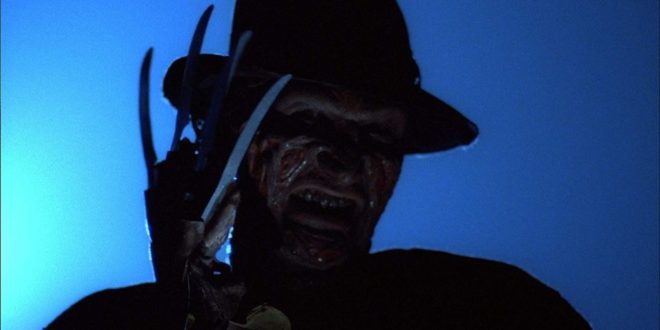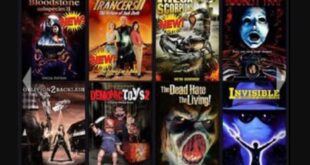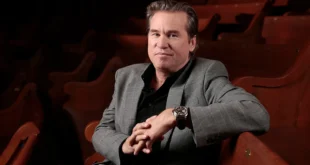Freddy Krueger (Robert Englund) is known as many things: A dirty child murderer called “The Springwood Slasher,” a burnt-faced psychopath, a dream demon and the “bastard son of a hundred maniacs.” He is also the Nightmare on Elm Street franchise’s primary villain and a pop culture icon. Freddy has joined the pantheon of cinematic horror icons where he has a permanent place. All that aside, let’s look into the tortured/torturing mind of one of horror’s most enduring menaces. It turns out he’s a rather complicated character, and it’s likely that a force greater than himself feeds his evil.
A Nightmare On Elm Street (1984)
In Wes Craven’s original film, Fred Krueger is introduced as a menace straight away, building his iconic razor glove for his right hand, ready to slash at anyone who catches his ire (which, it turns out, is nearly anyone). What’s interesting, though, are the immediate clues about Freddy himself. He obviously has knowledge of how to manufacture the glove. Putting aside his twisted intent, it suggests someone with experience crafting metal and who knows the mechanics of things. He is akin to horror’s blacksmith, and it implies a working class background. Though he uses it to slash at the nightgown of Tina Grey (Amanda Wyss), it’s highly likely he’s a reasonably skilled tradesman. Based on a scene in this film, it could be theorized that Freddy was a maintenance man at Springwood’s high school. However, the sequel suggests (very directly) that Freddy worked at a factory and frequently took his victims to its boiler room.

This background clues us in to Freddy’s intelligence level. He probably wasn’t just some random drifter, but someone who could retain employment while secretly enacting his revenge fantasies. Freddy’s Dead strongly hints that he was abused and bullied as a child, and he may have targeted the children of those who mocked him. Therefore, as odd as this sounds, Freddy is secretly actually very sensitive, which animates his rage very quickly. He, quite clearly, hates the world and anyone who is even slightly linked to those who wronged him. As Freddy actually has some reasoning power, this self-justification no doubt feeds into his sadism. So the question is: who wouldn’t Freddy kill? Could he actually take pity on someone and decide to kill them relatively painlessly?
In A Nightmare on Elm Street, there are few signs of this. If you look at how he killed Glen Lantz (Johnny Depp), there are blatant signs of overkill (he delights in almost comically exaggerated bloodshed). Similarly, Rod Lane (Jsu Garcia/Nick Corri) is hung, but his imminent death is also used to haunt Nancy (Heather Langenkamp).
Freddy’s Looks

Freddy Krueger is disfigured from the burns gained from vengeful parents who “roasted him like a Thanksgiving turkey” (as phrased in The Dream Master). While this act feeds Freddy’s rage, he also uses his looks to drive additional fear into his targets. He knows most people are too superficial to look past his disfigurement. It’s also a permanent reminder that he was himself wronged, and therefore may make the character feel more justified in his behavior (though his sadism helps).
Meanwhile, the red and green sweater suggests a bit of a fashion misfit, although the hat gives him a certain style. It’s also undeniable that Freddy moves with a confident swagger, suggesting someone who is very comfortable with killing people. He no doubt thinks it’s cool, and maybe his primary purpose in life. While this suggests a man whose circuits have been scrambled, it’s also eerily similar to how real life serial killers view themselves (we’ll get more into that in future installments).
Why Only Children And Not Parents? Well, Actually…
It’s easy to speculate that, in the dreamscape, Freddy cannot directly go after the parents who slayed him. However, let’s not forget that he also targeted children while alive. So, rather than only being a cosmic necessity for the character, Freddy Krueger likely targets teenagers of those who wronged him because he wants to. It’s also possible that, for whatever reason, he fears the parents more, being that they were originally successful in meting out street justice. Also, what hurts a parent more than when their children are harmed?
Of course, things get complicated when we consider that, technically, Freddy can kill adults, and sometimes does. In fact, in this first installment he apparently kills Nancy’s mom (Ronee Blakley) when out of the dreamscape. At the time, though, there are signs that he may actually still be in the dream (although that’s never entirely clear, either). On that note…

Freddy’s Powers In Part 1
Let’s consider Freddy Krueger as a powerful being in the original A Nightmare on Elm Street. It’s clear that Freddy is strong, but it’s always implied that his power has limits (even if not specifically enumerated). While he holds back to play with his victims as a cat does with a mouse, at no point does he seem absolutely invulnerable. This gets to the whole “mind over matter” dynamic (to borrow Sheila’s language from Dream Master).
To some degree, Freddy’s power is limited by the fear levels of his victims. In fact, it’s entirely plausible that there are some people he wouldn’t even go after, especially if they have few mental weaknesses to exploit. Yet again, this has analogues to real life serial killers who only target those they see as opportune. While the original Nightmare on Elm Street never speculates where Freddy Krueger got his dream powers from, it’s implied that he is not truly omnipotent, though he views himself as “God.”
What are your thoughts on Freddy Krueger in the original A Nightmare on Elm Street? Let us know in the comments!
 PopHorror Let's Get Scared
PopHorror Let's Get Scared




